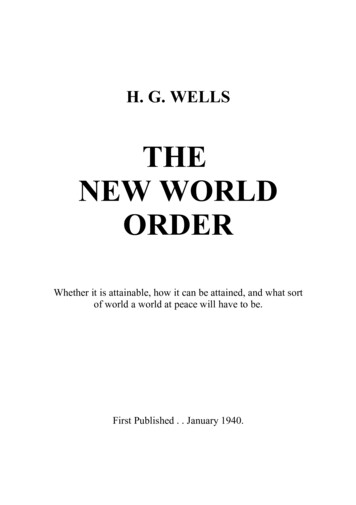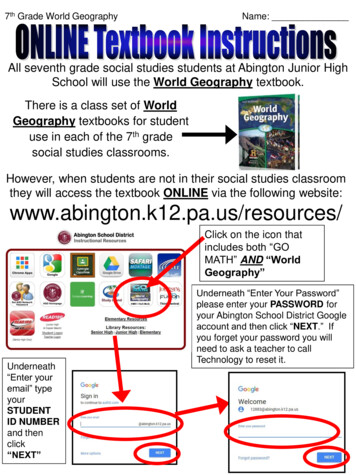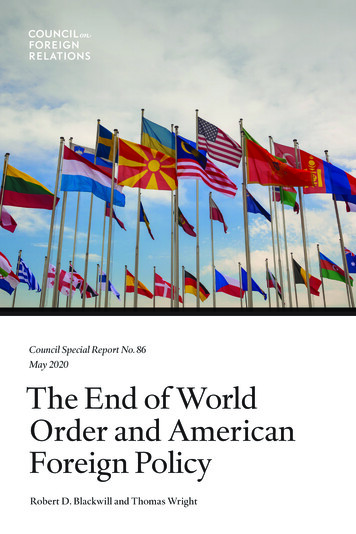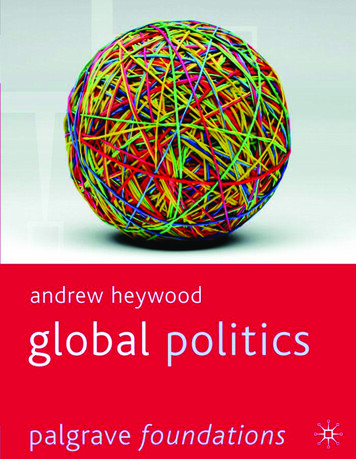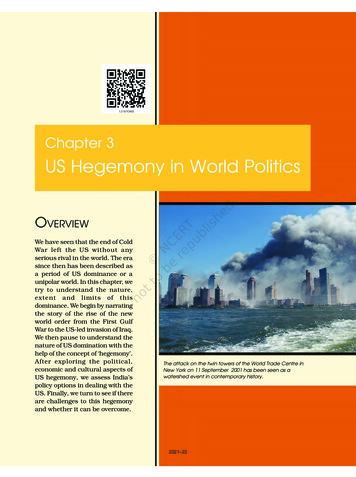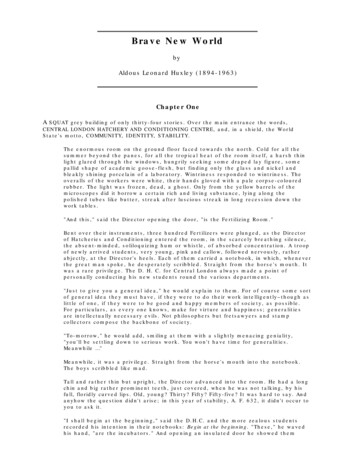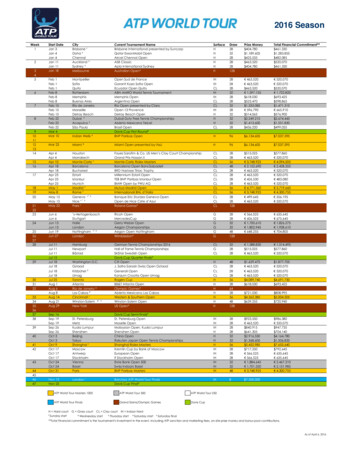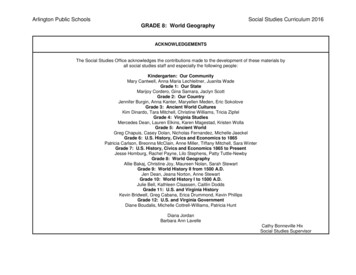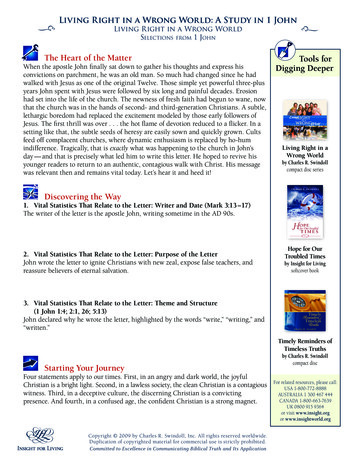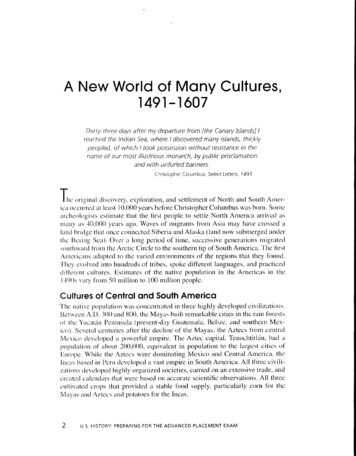
Transcription
A New World of Many Cultures,1491 1607Thirty-three days after my departure from [the Canary Islands] Ireached the Indian Sea, where I discovered many islands, thicklypeopled, of which I took possession without resistance in thename of our most illustrious monarch, by public proclamationand with unfurled banners.Christopher Columbus, Select Letters, 1493.he original discovery, exploration, and settlement of North and South America occurred at least . 10,000 years before Christopher Columbus was born. Somearcheologists estimate that the first people to settle North America arrived asmany as 40,000 years ago. Waves of migrants from Asia may have crossed aland bridge that once connected Siberia and Alaska (land now submerged underthe Bering Sea). Over a long period of time, successive generations migratedsouthward from the Arctic Circle to the southern tip of South America. The firstAmericans adapted to the varied environments of the regions that they found.They evolved into hundreds of tribes, spoke different languages, and practiceddifferent cultures. Estimates of the native population in the Americas in the1490s vary from 50 million to .100 million people.Cultures of Central and South AmericaThe native population was concentrated in three highly developed civilizations.Between A.D. 300 and 800, the Mayas built remarkable cities in the rain forestsof the 'Yucatan Peninsula (present-day Guatemala, Belize, and southern Mexico). Several centuries after the decline of the Mayas, the Aztecs from central.Mexico developed a powerful empire. The Aztec capital, Tenochtitlan, had apopulation of about 200.000, equivalent in population to the largest cities ofEurope. While the Aztecs were dominating Mexico and Central America, theIncas based in Peru developed a vast empire in South America. All three civilizations developed highly organized societies, carried on an extensive trade, andcreated calendars that were based on accurate scientific observations. All threecultivated crops that provided a stable food supply, particularly corn for theMayas a.nd Aztecs and potatoes for the Incas.2U. S. HISTORY. PREPARING FOR THE ADVANCED PLACEMENT EXAM
Cultures of North AmericaThe population in the region north of Mexico (present-day United States andCanada) in the 1490s may have been anywhere from under I million to morethan 10 million. In general, the native societies in this region were smaller andless sophisticated than those in Mexico and South America. One reason for thiswas the slowness of the northward spread of corn cultivation from Mexico.Some of the most populous and complex societies in North America haddisappeared by the 15th century, for reasons not well understood. By the timeof Columbus, most people in the Americas in what is now the United States andCanada lived in semipermanent settlements in groups seldom exceeding 300people. The men spent their time making tools and hunting for game, whilethe women gathered plants and nuts or grew crops such as corn, beans. andtobacco.NATIVE PEOPLES OF THE AMERICAS 1491ArcticSubarcticNorthwest CoastCaliforniaPlateauGreat aribbean1000 Mlles11000 KMA NEW WORLD OF MANY CULTURES, 1491-16073
Language Beyond these similarities, the cultures of American IndiansWere very diverse, For example, while English, Spanish, and almost all otherEuropein kingwiges Were part Of just one language family (Indo-Europetn),American Indian languages constituted more than 20 language families.Among the largest of these were Algonquian in the Northeast, Siouan oil theGreat Plains, and .Athabaskan in the Southwest. Together, these 20 familiesincluded more than 400 distinct languages.Southwest Settlements In the dry region that now includes New :Mexico anal Arizona, groups such as the Hokokam, Anasazi, and Pueblos evolvedmultifaceted societies supported by farming with irrigation systems. In largenumbers they lived in caves, under cliffs, and in multistoried buildings. By thetime Europeans arrived, extreme drought and other hostile natives had takentheir toll On these groups. However, much of their way of life was preserved inthe arid land and their stone and masonry dwellings.Northwest Settlements Along the Pacific coast from what is todayAlaska to northern California, people lived in permanent longhouses or plankhouses, 'f hey had a rich diet based on hunting, fishing, and gathering nuts,berries, and roots. To save stories, legends, and myths, they carved large totempoles, The high mountain ranges in this region isolated tribes from one another,creating barriers to development.Great Plains Most people who lived on the Great Plains were eithernomadic hunters or sedentary people who farmed and traded. The nomadictribes survived on hunting, principally the buffalo, which supplied their food aswell as decorations, crafting tools, knives, and clothing. They lived in tepees.frames of poles covered in animal skins, which were easily disassembled andtransported. While the farming tribes also hunted buffalo, they lived permanently in earthen lodges often along rivers. They raised corn, beans, and squashwhile actively trading with other tribes. Not until the 17th century did American Indians acquire horses by trading or stealing them from Spanish settlers.With horses, tribes such as the Lakota Sioux moved away from farming tohunting and easily following the buffalo across the plains. The plains tribeswould at times merge or split apart as conditions changed. Migration also wascommon. For example, the Apaches gradually migrated southward from Canada to Texas.Midwest Settlements East of the Mississippi River, the Woodland Amercan Indians prospered with a rich food supply. Supported by hunting, fishing.and agriculture, many permanent settlements developed in the Mississippi andOhio River valleys and elsewhere. The Adena-Hopewell culture, centered inwhat is now Ohio, is famous for the large earthen mounds it created, someas large as 300 feet long. One of the largest settlements in the Midwest wasCahokia (near present-day East St. Louis, Illinois), with as many as 30 000inhabitants.Northeast Settlements Some descendants of the Adena-Hopewell culture spread from the Ohio Valley into New York. Their culture combined hunting4usHISTORY: PREPARING FOR THE ADVANCED PLACEMENT EXAM
and farming. However, their farming techniques exhausted the soil quickly, sopeople had to move to fresh land frequently. Among the most famous groupsof American Indians in this region was the Iroquois Confederation, a politicalunion of five independent tribes who lived in the Mohawk Valley of New York.The five tribes were the Seneca, Cayuga, Onondaga, Oneida, and Mohawk.Multiple families related through a mother lived in longhouses, up to 200 feetlong. From the 16th century through the American Revolution, the Iroquoiswere a powerful force, battling rival American Indians as well as Europeans.Atlantic Seaboard Settlements In the area from New Jersey south toFlorida lived the people of the Coastal Plains. Many were descendants of theWoodland mound builders and built timber and bark lodgings along rivers. Therivers and the Atlantic Ocean provided a rich source of food.Europe Moves Toward ExplorationUntil the late 1400s, Americans and the people of Europe, Africa, and Asiahad no knowledge of the people on the other side of the Atlantic Ocean. WhileVikings from Scandinavia had visited Greenland and North America aroundthe year 1000, these voyages had no lasting impact. Columbus's voyages ofexploration finally brought people into contact across the ,Atlantic. Several factors made an oceanic crossing and exploration possible in the late 1 5th century.Improvements in TechnologyIn Europe., a rebirth of classical learning prompted an outburst of artistic an 1Al1centuries known as the Renaissance.scientific activity in the 15th an I c1(1Several of the technological advances during the Renaissance resulted fromEuropeans making improvements in the inventions of others. For example,they began to use gunpowder (invented by the Chinese) and the sailing compass (adopted from Arab merchants who learned about it from the Chinese).Europeans also made major improvements in shipbuilding and mapmaking. Inaddition, the invention of the printing press in the 1450s aided the spread ofknowledge across Europe.Religious ConflictThe later years of the Renaissance were a time of intense religious zeal andconflict. The Roman Catholic Church that had once dominated Western Europewas threatened from without by Ottoman Turks who were followers of Islamand from within by a revolt against the pope's authority.Catholic Victory in Spain In the 8th century, Islamic invaders fromNorth Africa, known as Moors, rapidly conquered most of what is now Spain.Over the next several centuries, Spanish Christians reconqucred much of theland and set up several independent kingdoms. Two of the largest of these kilq :',-doms united when Isabella, queen of Castile. and Ferdinand, king of Aragon,married in 1469. In 1492, under the leadership of Isabella and Ferdinand, theSpanish conquered the last Moorish stronghold in Spain, the city of Granada.In that year, the monarchs also funded Christopher Columbus on his historicA NEW WORLD OF MANY CULTURES, 1491-16075
first voyage. The uniting of Spain under Isabella and Ferdinand, the conquestof Granada., and the launching of Columbus signaled new leadership, hope, andpower for Europeans who followed the Roman Catholic faith.Protestant. Revolt in Northern Europe in the early 1500s, certain Christians in Germany, England, France, Holland, and other northern Europeancountries revolted against the authority of the pope in Rome. Their revolt wasknown as the Protestant Reformation. Conflict between Catholics and Protestants led to a series of religious wars. The conflict also caused the Catholics ofSpain and Portugal and the Protestants of England and Holland to want to spreadtheir own versions of Christianity to people in Africa, Asia, and the Americas.Thus, a religious motive for exploration and colonization was added to politicaland economic motives.Expanding TradeEconomic motives for exploration grew out of a fierce competition among European kingdoms for increased trade with Africa, India, and China. In the past,merchants had traveled from the Italian city-state of Venice and the Byzantinecity of Constantinople on a long, slow, expensive overland route that reached allthe way to the capital of the Chinese empire. This land route to Asia had becomeblocked in '1453 when the Ottoman Turks seized control of Constantinople.New Routes So the challenge to finding a new way to the rich Asiantrade appeared to be by sailing either south along the West. African coast east toChina, or sailing west across the Atlantic Ocean. The Portuguese., who realizedthe route south and east was the shortest path, thought this option seemed morepromising. Voyages of exploration sponsored by Portugal's Prince 'Henry theNavigator eventually succeeded in opening up a long sea route around SouthAfrica's Cape of Good Hope. In 1498, the Portuguese sea captain Vasco daGama was the first European to reach India via this route. By this time, Columbus had attempted what he mistakenly believed would be a shorter route to Asia.Slave Trading Since ancient times people in Europe, Africa, and Asia hadenslaved people captured in wars. In the 15th century, the Portuguese. begantrading for slaves from West Africa. They used the slaves to work newly established sugar plantations on the Madeira and Azores islands off the African coast.Producing sugar with slave labor was so profitable that when Europeans laterestablished colonies in the Americas, they used the slave system there.African Resistance Enslaved Africans resisted slavery in whatever waysthey could. 'Fhough transported thousands of miles from their homelands andbrutally repressed, they often ran away, sabotaged work, or revolted. And forgenerations they maintained aspects of their African culture, particularly inmusic, religion, and folkways.Developing Nation States-Europe was also changing politically in the 15th century. Small kingdoms, suchas Castile and Aragon, were uniting into larger ones. Enormous multiethnicempires, such as the sprawling Holy Roman Empire in central Europe, were6U.S. HISTORY: PREPARING FOR THE ADVANCED PLACEMENT EXAM
breaking up. Replacing the small kingdoms and the multiethnic empires werenation-states, countries in which the majority of people shared both a common culture and common loyalty toward a central government. The monarchsof the emerging nation-states, such as Isabella and Ferdinand of Spain; PrinceHenry the Navigator of Portugal; and similar monarchs of France, England,and the Netherlands; depended on trade to bring in needed revenues and on thechurch to justify their right to rule. They used their power to search for richesabroad and to spread the influence of their version of Christianity to new overseas dominions.Early ExplorationsChangin2- economic, political, and social conditions in Etii pe shaped the ambitions of the Italian-born Christopher Columbus,Christopher ColumbusColumbus spent eight years seeking financial support for his plan to sail vestfrom Europe to the 'Indies." Finally, in 1492, he succeeded in winning thebacking of Isabella and Ferdinand. The two Spanish monarchs were then at theheight of their power., having just defeated the Moors in Gnimida. They .t.greedto outfit three ships and to make Columbus governor, admiral, and viceroy of allthe lands that he would claim for Spain.After sailing from the Canary Islands on September 6, Columbus landed onan island in the Bahamas on October 12. His success in reaching lands on theother side of the ocean brought him a burst of glory in Spain. But three subsequent voyages across the Atlantic were disappointing—he found little gold, fewspices, and no simple path to China and India.Colu.mbus's Legacy Columbus died in 1506, still believing that he hadfound a western route to Asia. However, many Spaniards viewed Columbus as afailure because they suspected that he had found not a valuable trade route, buta "New World." Today, some people scoff at Columbus for having erroneouslygiving the people he encountered the name "Indians." Even the land that he hadexplored was named for someone else, Amerigo Vespucci, another Italian sailor.Columbus's critics also point out the many problems and injustices suffered bythe natives of the Americas after Europeans arrived and took over their land.Nevertheless, most historians agree on Columbus's importance. Modernscholars have recognized his great skills as a navigator and his daring commitment in going forth where nobody else had ever dared to venture. Furthermore.Columbus's voyages brought about, for the first time in history. permanent interaction between people from all over the globe. He changed the world forever.Exchanges Europeans and the original inhabitants of the Americas haddeveloped vastly different cultures over the. millennia. The contact betweenthem resulted in the Columbian Exchange, a transfer of plants, animals, andgerms from one side of the Atlantic to the other for the first time. Europeanslearned about many new plants and foods, including beans, corn, sweet andA NEW WORLD OF MANY CULTURES, 1491-16077
white potatoes, tomatoes, and tobacco. They also contracted a new disease,syphilis. Europeans introduced to the Americas sugar cane, bluegrasses, pigs,and horses, as well as the wheel, iron implements, and guns. Deadlier than allthe pins was the European importation of germs and diseases, such as smallpoxand measles. to which the natives had no immunity. Millions died (there wasa mortality rate of more than 90 percent), including entire tribal communities.rfhese exchanges. biological and cultural, would permanently change the entireworld.Dividing the AmericasSpain and Portugal were the first. European kingdoms to claim territories in theAmericas. Their claims overlapped, leading to disputes. The Catholic monarchsof the two countries turned to the pope in Rome to resolve their differences. In1493, the pope drew a vertical, north-south line on a world map, called the lineof demarcation. The pope granted Spain all lands to the west of the line andPortugal all lands to the east.In 1494, Spain and Portugal moved the pope's line a few degrees to thewest and signed an agreement called the Treaty of Tordesillas. The line passedthrough hat is now the country of Brazil. This treaty, together with Portugueseexplorations. established -Portugal's claim to Brazil. Spain claimed the rest ofthe Americas. However. other European countries soon challenged these claims.Spanish Exploration and ConquestSpanish dominance in the Americas was based on more than a papal ruling anda treaty. Spain owed its expanding power to its explorers and conquerors (calledconqui.sladores). Feats such as the journey across the Isthmus of Panama to thePacific Ocean by Vasco Ntifiez de Balboa, the circumnavigation of the world byone of Ferdinand Magellan's ships (Magellan died before completing the trip . ),the conquests of the Aztecs in Mexico by Hernan Cortes, and the conquest ofthe Incas in Peru by Francisco Pizzaro secured Spain's initial supremacy in theAmericas.The conquistadores sent ships loaded with gold and silver back to Spainfrom Mexico and Peru. They increased the gold supply by more than 500 percent, making Spain the richest and most powerful nation in Europe. Spain'ssuccess encouraged other nations to turn to the Americas in search of gold andpower. After seizing the wealth of the Indian empires, the Spanish instituted anencomienda system, with the king of Spain giving grants of land and nativesto individual Spaniards. These Indians had to farm or work in the mines. Thefruits of their labors went to their Spanish masters, who in turn had to "care" forthem. As Europeans' diseases and brutality reduced the native. population, theSpanish brought enslaved people from West Africa under the aviento system.This required the Spanish to pay a tax to their king on each slave they importedto the Americas.8U.S. HISTORY: PREPARING FOR THE ADVANCED PLACEMENT EXAM
EARLY SETTLEMENTS IN NORTH AMERICA1. 600S117 se.:%-.4k)English and Dutchcolonies1000 0.411Q660001000 KS00mv0'.Quebec #1NORTHUR ANCMontrea'1)'AMERICA;Plymouth.c .il.,t . -!New\ AmsterdamJamestownRoanoke ISanta FeNELOUIS'I ANAwMkX iC01:1:A St. AugustineNEWSPAINEnglish ClaimsEngland's earliest claims to territory in the Americas rested on the voyages ofJohn Cabot, an Italian sea captain who sailed under contract to England's KingHenry VII. Cabot explored the coast of Newfoundland in .1497.England, however, did not follow up Cabot's discoveries with other expeditions of exploration and settlement. Other issues preoccupied England'smonarchy in the 1500s, including Henry break with the Roman CatholicChurch. In the 1570s and I 580s, under Queen Elizabeth I. England challengedSpanish shipping in both the Atlantic and Pacific Oceans. Sir Francis Drake, forexample, attacked Spanish ships, seized the gold and silver that they carried,and even attacked Spanish settlements on the coast of Peru. Another Englishadventurer, Sir Walter Raleigh, attempted to establish a settlement at RoanokeIsland off the North Carolina coast in 1587, but the venture failed.A NEW WORLD OF MANY CULTURES, 1491-16079
French ClaimsThe French monarchy first showed interest in exploration in 1524 when it sponsored a voyage by an Italian navigator, Giovanni da Verrazano. Hoping to findnorthwest passage leading through the Americas to Asia, Verrazano exploredpart of North America's eastern coast, including the New York harbor. Frenchclaims to .American territory were also based on the voyages of Jacques Cartier(1534-1542), \vho explored the St. Lawrence River extensively.Like the En{4.1ish, the French were slow to develop colonies across the Atlantic. During the 1500s, the French monarchy was preoccupied with Europeans as well as with internal religious conflict between Roman Catholics andFrench Protestants known as Huguenots. Only in the next. century did Francedevelop a strong interest in following up its claims to North American land.The. first permanent French settlement in America was established by Samuelde Champlain in 1608 at Quebec, a .fortified village on the St. Lawrence River.Champlain's strong leadership won him the nickname "Father of New France."Other explorers extended French claims across a vast territory. In 1673, LouisJolliet and Father Jacques Marquette explored the upper Mississippi River, andin 1682, Robert de La Salle explored the Mississippi basin, which he namedLouisiana (after the French king, Louis XIV).Dutch ClaimsDuring the 1600s, the Netherlands also began to sponsor voyages of exploration. The Dutch government hired Henry Hudson, an experienced Englishsailor, to seek westward passage to Asia through northern America. In 1609,while searching for a northwest passage., Hudson sailed up a broad river that.was later named for him, the Hudson River. This expedition established Dutchclaims to the surrounding area that would become New Amsterdam (and laterNew York). The Dutch government granted a private company, the Dutch West.India Company, the right to control the region for economic gain.Spanish Settlements in North AmericaSpanish settlements developed slowly in North America, as a result of limitedmineral resources and strong opposition from American Indians.Florida After a number of failed attempts and against the. strong resistance of American Indians in the region, the Spanish established a permanentsettlement at St. Augustine in 1565. Today, St. Augustine is the oldest city inNorth America founded by Europeans.New Mexico Santa Fe was established as the capital of New Mexico in1610. Harsh efforts to Christianize. the American Indians caused the Pueblopeople to revolt in 1680. The Spanish were driven from the area until 1692.Texas in between Florida and New Mexico, the Spanish established settlements in Texas. These communities grew in the early 1700s as Spain attemptedto resist French efforts to explore the lower Mississippi River.10U.S. HISTORY: PREPARING FOR THE ADVANCED PLACEMENT EXAM
California In response to Russian exploration from Alaska. the Spanishestablished permanent settlements at San Diego in 1769 and San Francisco in1776. By 1784, a series of missions or settlements had been established alongthe California coast by members of the Franciscan order. Father Junipero Serrafounded nine of these missions.European Treatment of Native AmericansMost Europeans looked down upon Native Americans. The Europeans who colonized North and South America generally viewed Native Americans as inferiorpeople who could be exploited for economic gain, converted to Christianity,and used as military allies. However, Europeans used various approaches forcontrolling Native Americans and operating their colonies.Spanish PolicyThe Spanish who settled in Mexico and Peru encountered the highly organized Aztec and Inca empires. Even after diseases killed most natives, millionsremained in these empires that the Spanish could incorporate as laborers in theirown empire. Many natives who did not die from disease died from forced labor.Because few families came from Spain to settle the empire. the explorers andsoldiers intermarried with natives as vell as with Africans. The latter were captured in Africa. and breed to travel across the ocean to provide slave labor forthe Spanish colonists. A rigid class system developed in the Spanish colonies,one dominated by pure-blooded Spaniards.Bartotome de Las Casas One European who dissented from the viewsof most Europeans toward Native Americans was a Spanish priest named Bartolome de Las Casas. Though he had owned land and slaves in the West. Indiesand had fought in wars against. the Indians, he eventually became an advocatefor better treatment for Indians. He persuaded the king to institute the NewLaws of 1542. These laws ended Indian slavery, halted forced Indian labor,and began to end the encomienda system which kept the Indians in serfdom.Conservative Spaniards, eager to keep the encomienda system. responded andsuccessfully pushed the king to repeal parts of the New Laws.Valladolid Debate The debate over the role for Indians in the. Spanishcolonies came to a head in a formal debate in 1550-1551 in 'Valladolid, Spain.On one side, Las Casas argued that the Indians were completely human andmorally equal to Europeans, so enslaving them was not justified. On the otherside:, another priest, Juan Gines de Septilveda, argued that Indians were less thanhuman. Hence, they benefited from serving the Spaniards in the ecomniendasystem. Neither side clearly won the debate. Though Las Casas was unable togain equal treatment for Native Americans, he established the basic argumentson behalf of justice for Indians.A NEW WORLD OF MANY CULTURES, 1401-160711
English PolicyUnlike the Spanish, the English settled in areas without large native empiresthat could he controlled as a workforce. In addition, many English colonistscame in families rather than as single young men, so marriage with natives NA, asless common. initially. at least in Massachusetts, the English and the i\merican Indians coexisted. traded. and shared ideas. American Indians taught thesettlers how to grow new crops such as corn and showed them how to huntin the forests. They traded various furs for an array of English manufacturedg oods, including iron tools and weapons. But peaceful relations soon gave wayto conflict and open warfare. The English had no respect for American Indiancultures., which they viewed as primitive or -savage.- For their part. AmericanIndians saw their way of life threatened as the English began to take more landto support their ever-increasing population. The English occupied the land andforced the small, scattered tribes they encountered to move away from the coast.U) inland territories. They expelled the natives rather than subjugating them.'French PolicyThe French, looking for furs and converts to Catholicism, viewed AmericanIndians as potential economic and military allies. Compared to the Spaniardsand the English, the French maintained good relations with the tribes theyencountered, Seeking to control the fur trade, the French built trading poststhroughout the St. Lawrence Valley, the Great Lakes region, and along the Mississippi Riser. At these posts. they exchanged French goods for beaver pelts andother furs collected by American Indians. Because the French had few colonists,farms, or towns. they posed less threat to the native population than did otherEuropeans. In addition, French soldiers assisted the Huron people in lightingtheir traditional enemy. the Iroquois.Native American ReactionNorth American tribes saw themselves as groups distinct from each other, notas part of a larger body of Native Americans. As a result, European settlersrarely had to he concerned with a unified response from the Native Americans.Initially the European goods such as copper pots and guns had motivated thenatives to interact with the strangers. After the decimation of their peoples fromthe violence and disease of the Europeans, the Native Americans had to adopt.new ways to survive. Upon observing the Europeans lighting each other, sometribes allied themselves with one European power or another in hopes of gaining support in order to survive. A number of tribes simply migrated to new landto get away from the slowly encroaching settlers. Regardless of how they dealtwith the European invasion, Native Americans would never bey able to return tothe life they had known prior to 1492.12U.S. HISTORY: PREPARING FOR THE ADVANCED PLACEMENT EXAM
HISTORICAL PERSPECTIVES: WAS COLUMBUS A GREAT HERO?Over the centuries, Columbus has received both praise for his role as a"discoverer" and blame for his actions as a "conqueror." in the UnitedStates, he has traditionally been viewed as a hero. As early as 1828, Washington Irving wrote a popular biography extolling the explorer's virtues.The apex of Columbus's heroic reputation was reached in 1934 whenPresident Franklin Roosevelt declared October 12 a national holiday.Since the 1990s, however, revisionist histories and biographies havebeen highly critical of Columbus. His detractors argue that Columbus wassimply at the right place at the right time. Europe at the end of the 15thcentury was ready to expand. If Columbus had not crossed the Atlanticin 1492, some other explorer—perhaps Vespucci or Cabot—would havedone so a few years later. According to this interpretation. Columbus waslittle more than a good navigator and a self-promoter who exploited anopportunity.Some revisionists take a harsh view of Columbus and regard him notas the first discoverer of America but rather as its first conqueror. 'Theyportray him as a religious fanatic in the European Christian tradition whosought. to convert the American natives to Christianity and liquidatedthose who resisted.The revisionist argument has not gone unanswered. For example,historian Arthur M. Schlesinger Jr. has argued that the chief motivationfor Columbus's deeds was neither greed for gold nor ambition for conquest. What drove him, in Schlesinger's view, was the challenge of theunknown. Columbus's apologists admit that millions of Native Americans died as a result of European exploration in the Americas, but thepoint out that an unknown number had suffered horrible deaths in Aztecsacrifices. Moreover, the mistreatment of Native Americans was perhapspartially offset by such positive results as the gradual development ofdemocratic institutions in the colonies and later the United States.Historians will continue to debate the nature of Columbus's achievement. As with other historical questions, distinguishing between fact andfiction and. separati
A NEW WORLD OF MANY CULTURES, 1491-1607 5 . first voyage. The uniting of Spain under Isabella and Ferdinand, the conquest of Granada., and the launching of Columbus signaled new leadership, hope, and power for Europeans who followed the Roman Catholic faith. Protestant. Rev
